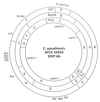Campylobacter upsaliensis: waiting in the wings
- PMID: 9665977
- PMCID: PMC88890
- DOI: 10.1128/CMR.11.3.440
Campylobacter upsaliensis: waiting in the wings
Abstract
Despite strong epidemiological evidence supporting an important role for Campylobacter upsaliensis as a human enteropathogen, it remains relatively unknown in the realm of clinical microbiology. Clinical studies indicate that infection with this organism usually is associated with benign self-limiting diarrhea. However, more serious illnesses, including spontaneous abortion and hemolytic-uremic syndrome, recently have been associated with human infections. Understanding of the virulence properties and molecular biology of C. upsaliensis is beginning to evolve. There is now a pressing need for controlled, prospective epidemiologic studies in addition to further in-depth investigation of the pathogenesis of this enteric campylobacter to more precisely define its role in human disease. Furthermore, since C. upsaliensis is sensitive to the antibiotics routinely used in Campylobacter selective media, widespread appreciation of the importance of this organism will rely on the development of widely applicable, effective techniques for its isolation.
Figures




References
-
- Alderton M R, Korolik V, Coloe P J, Dewhirst F E, Paster B J. Campylobacter hyoilei sp. nov., associated with porcine proliferative eneteritis. Int J Syst Bacteriol. 1995;45:61–66. - PubMed
-
- Anonymous. Validation of the publication of new names and new combinations previously effectively published outside the IJSB. Int J Syst Bacteriol. 1991;41:331. - PubMed
-
- Aspinall S T, Wareing D R A, Hayward P G, Hutchinson D N. A comparison of a new selective medium (CAT) with membrane filtration for the isolation of thermophilic campylobacters including Campylobacter upsaliensis. J Appl Bacteriol. 1996;80:645–650. - PubMed
Publication types
MeSH terms
LinkOut - more resources
Full Text Sources
Medical
Molecular Biology Databases

